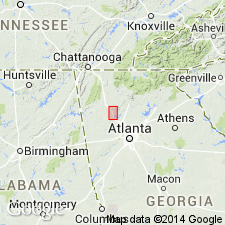
- Usage in publication:
-
- Pinelog conglomerate
- Modifications:
-
- Named
- Dominant lithology:
-
- Conglomerate
- Arkose
- Quartzite
- AAPG geologic province:
-
- Appalachian basin
Summary:
Name attributed to Hayes (unpublished manuscript) which he used for a conglomeratic gneiss. Probably named for Pinelog Mountain, Bartow Co., northwestern GA. Consists of a rather heterogeneous formation of conglomerate, arkose, quartzite, siliceous phyllite, and graphitic slate, all much sheared and largely altered to sericite schist and gneiss; its base, in places, is arkose. Rests on Corbin gneiss; underlies slate regarded by Hayes as Wilhite slate of Tennessee. [No age given. Wilmarth (1938, US geologic names lexicon, USGS Bull. 896) says Early Cambrian.]
Source: GNU records (USGS DDS-6; Reston GNULEX).
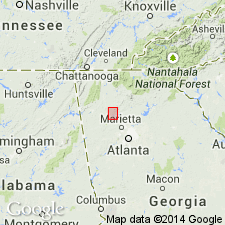
- Usage in publication:
-
- Pinelog conglomerate
- Modifications:
-
- Areal extent
- AAPG geologic province:
-
- Appalachian basin
Summary:
Pinelog conglomerate borders the area of Corbin granite on all sides but the southeast and forms Pinelog, Pine, and eastern part of Brushy Knob and Signal Mountains.
Source: GNU records (USGS DDS-6; Reston GNULEX).
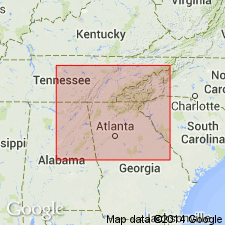
- Usage in publication:
-
- Pinelog conglomerate
- Modifications:
-
- Revised
- AAPG geologic province:
-
- Appalachian basin
Summary:
Pinelog conglomerate of Bartow Co. is claimed by LaForge (1919) to be lower part of Weisner quartzite, but Pinelog appears to lie at base of Talladega series where Weisner is top of Lower Cambrian arenaceous series.
Source: GNU records (USGS DDS-6; Reston GNULEX).
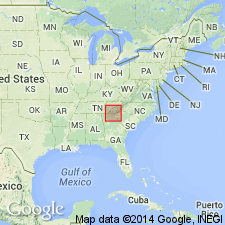
- Usage in publication:
-
- Pine Log conglomerate
- Modifications:
-
- Overview
- AAPG geologic province:
-
- Appalachian basin
Summary:
[Misspelled as Pine Log.] Basal conglomerate beds of Pine Log conglomerate of east end of Pine Log Mountain, which lies north of Corbin granite and east of [Cartersville] fault are derived from Corbin granite and rest on that granite which is brought up in an anticline.
Source: GNU records (USGS DDS-6; Reston GNULEX).
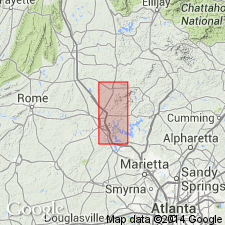
- Usage in publication:
-
- Pinelog conglomerate*
- Modifications:
-
- Revised
- AAPG geologic province:
-
- Appalachian basin
Summary:
For the purposes of this report, Pinelog conglomerate is included in Weisner formation. [Use of the name Pinelog is still correct.]
Source: GNU records (USGS DDS-6; Reston GNULEX).
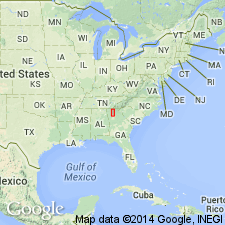
- Usage in publication:
-
- Pinelog Conglomerate
- Modifications:
-
- Revised
- AAPG geologic province:
-
- Appalachian basin
Summary:
McConnell and Costello (1980, Frey and Neathery, eds., Excursions in southeastern Geology, Geological Society of America Field Trip Guidebook v. 1, no. 12, p. 241-258) redefined Hayes' Pinelog conglomerate and Wilhite slate to Pinelog Formation and Wilhite Formation. Authors suggest that this report [rather than their 1980 report] serve as formal definition of Pinelog Formation. Pinelog is present in Salem Church anticlinorium and is composed of an interlayered sequence of metaconglomerates, metasandstones, and locally carbonaceous metasiltstone. Basal units that lie nonconformably on Corbin Gneiss Complex (1 b.y.) consist of well-sorted quartz-pebble metaconglomerates, metasandstone, and graphitic phyllite. These in turn are overlain by thickly bedded and graded metaconglomerates, cross-bedded metasandstone, graphitic phyllites, and thin lenses of immature, poorly sorted lithic metaconglomerates (diamictite). Greatest portion was derived from Corbin (as noted by Hayes, 1900). Gradationally above Pinelog is thin sequence of carbonaceous and noncarbonaceous, locally calcareous metasiltstone, metasandstone, and sandy marble equated with Wilhite slate by Hayes (unpub. data) of Cleveland folio, here formalized as Wilhite Formation. Pinelog is assigned to Snowbird group of Ocoee Supergroup based on lithologic correlation with Snowbird Group of King and others (158) and position under Wilhite Formation of Walden Creek Group. Age is Precambrian.
Source: GNU records (USGS DDS-6; Reston GNULEX).
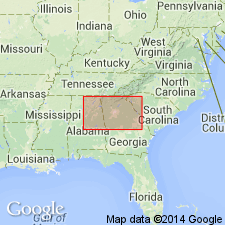
- Usage in publication:
-
- Pinelog Formation*
- Modifications:
-
- Revised
- Age modified
- AAPG geologic province:
-
- Appalachian basin
Summary:
The Pinelog Formation of the Ocoee Supergroup, as defined by McConnell and Costello (1984) is here accepted by the USGS for clastic metasedimentary rocks unconformably overlying the Allatoona Complex in the Bill Arp thrust sheet in northern GA. It stratigraphically underlies the Great Smoky Group in the Murphy synclinorium. Basal conglomerates of the Pinelog are derived from the Corbin Gneiss of the Allatoona. Age is Middle or Late Proterozoic.
Source: GNU records (USGS DDS-6; Reston GNULEX).
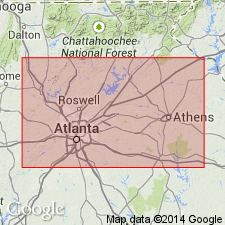
- Usage in publication:
-
- Pinelog Formation*
- Modifications:
-
- Revised
- Age modified
- AAPG geologic province:
-
- Appalachian basin
Summary:
Pinelog Formation removed from Ocoee Supergroup and is tentatively assigned to Chilhowee Group. Age is now considered Late Proterozoic to Early Cambrian. Contains metaconglomerate lenses that are derived from Corbin Metagranite (revised); quartzite of Pinelog contains lenses and thin layers of graphitic phyllite identical to that in Nantahala Formation. Pinelog and Nantahala may be facies of one another. Pinelog is lithologically identical to parts of Chilhowee Group exposed on Chilhowee Mountain, TN, and is in same structural position as Chilhowee in the orogen, has same relations to same Lower Cambrian units in Rome Valley to the west, and contains worm-tube molds like those found in Chilhowee in TN. Therefore, assignment is made to Chilhowee Group. In addition, Vineyard Mountain Member is named. Report includes geologic map and correlation chart.
Source: GNU records (USGS DDS-6; Reston GNULEX).
For more information, please contact Nancy Stamm, Geologic Names Committee Secretary.
Asterisk (*) indicates published by U.S. Geological Survey authors.
"No current usage" (†) implies that a name has been abandoned or has fallen into disuse. Former usage and, if known, replacement name given in parentheses ( ).
Slash (/) indicates name conflicts with nomenclatural guidelines (CSN, 1933; ACSN, 1961, 1970; NACSN, 1983, 2005, 2021). May be explained within brackets ([ ]).

